
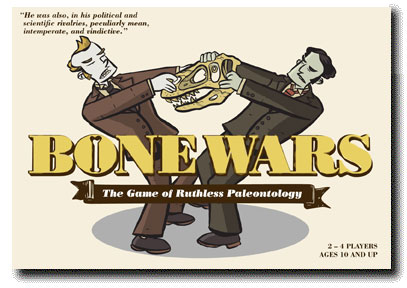 BONE
WARS
BONE
WARS
Zygote Games
$19.95
Bone Wars is a unique game from any point of view. Taxonomy card games fall into three broad categories. There are the games played on the standard 52 card playing decks, the massive collecting card games (CCG’s for short), and the card games that lie intermediate between the two to which Bone Wars belongs. A 99 cent deck of playing cards cannot be beat for value, but there are only so many strategies can be employed for any given game and play is pretty similar between hands. At the other end of the spectrum are the CCG’s that have an almost infinite number of strategies as a result of their having literally hundreds of cards and a system of rules that change over time. However, the CCG’s are usually sold in packs of about 10 cards requiring a considerable investment before you have a competitive deck, much time must be put building your decks before play can begin, and the rule books for these games resemble small tomes in size and complexity. Considering this state of affairs, it would be expected that there would be niche market of games that could combine the strategy and game play of the CCG’s without going overboard with the simplicity and one time price of a standard deck of playing cards. However, card games in this intermediate category have traditionally been far off this mark so that you would have more chance for strategy and interesting game play from a hand of Old Maid. Part of the problem is that many of these intermediate games are designed and marketed for younger children, which is the case for “Extinction,” the only other paleontological card game I know. Bone Wars is unique in that it manages to walk the line between the standard playing cards and the CCG’s taking many of their best elements, and does so in a smart manner that is enjoyable for both adults and older children.
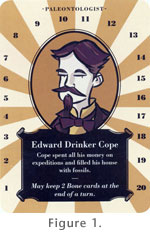 In Bone Wars, players portray
one of four paleontologists from the 19th century Bone Rush of the
American west (O.C. Marsh, Edward Cope, Charles Sternberg, and Barnum
Brown, see Figure 1) and compete for “Scientific Immortality” by
collecting Prestige Points. Each of these paleontologists is represented
by his own card that gives the player a particular advantage such as
drawing extra cards or starting with more Prestige Points. This among
many other touches results in no two games that are the same. Players
accrue prestige in one of three typical ways until they reach an agreed
upper limit and win the game. Prestige comes from describing dinosaurs,
revising your or other players’ skeletons, and using certain Event
cards. A round of play consists of three phases: Field Season, Museum
Work, and Controversy. During Field Season, players draw the Bone and
Event Cards they will use to build their skeletons in Museum Work and
revise them in Controversy. The Bone Cards consist of 18 Dinosaur cards
(see Figure 2) in four groups represented by their color, and a whole
series of Bone cards representing the Head, Vertebrae, and Limbs of the
similarly color-coded dinosaurs (See
Figure 3). As long as you have a
two different Bones of a Dinosaur of the same color, you can build a
skeleton in your “museum” and gain prestige. However, the Bone cards
have descriptions of their elements on them, and in Controversy players
can replace the bones of other players’ Dinosaurs with Bones that more
closely match their descriptions thereby allowing you to steal prestige
from an opponent. The true complexity of the game comes from the Event
cards (See Figure 4). Some Event cards can be played at particular
times, some prevent prestige lost, some help some help to describe
dinosaurs, and a large portion just stymie your opponents. The
interaction between these cards and the rest of the game is where the
game play takes on some of its most interesting aspects.
In Bone Wars, players portray
one of four paleontologists from the 19th century Bone Rush of the
American west (O.C. Marsh, Edward Cope, Charles Sternberg, and Barnum
Brown, see Figure 1) and compete for “Scientific Immortality” by
collecting Prestige Points. Each of these paleontologists is represented
by his own card that gives the player a particular advantage such as
drawing extra cards or starting with more Prestige Points. This among
many other touches results in no two games that are the same. Players
accrue prestige in one of three typical ways until they reach an agreed
upper limit and win the game. Prestige comes from describing dinosaurs,
revising your or other players’ skeletons, and using certain Event
cards. A round of play consists of three phases: Field Season, Museum
Work, and Controversy. During Field Season, players draw the Bone and
Event Cards they will use to build their skeletons in Museum Work and
revise them in Controversy. The Bone Cards consist of 18 Dinosaur cards
(see Figure 2) in four groups represented by their color, and a whole
series of Bone cards representing the Head, Vertebrae, and Limbs of the
similarly color-coded dinosaurs (See
Figure 3). As long as you have a
two different Bones of a Dinosaur of the same color, you can build a
skeleton in your “museum” and gain prestige. However, the Bone cards
have descriptions of their elements on them, and in Controversy players
can replace the bones of other players’ Dinosaurs with Bones that more
closely match their descriptions thereby allowing you to steal prestige
from an opponent. The true complexity of the game comes from the Event
cards (See Figure 4). Some Event cards can be played at particular
times, some prevent prestige lost, some help some help to describe
dinosaurs, and a large portion just stymie your opponents. The
interaction between these cards and the rest of the game is where the
game play takes on some of its most interesting aspects.
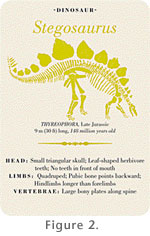 Much design has been put into the cards
themselves. The card art was created by Bryant P. Johnson, author for
the online comic Teaching Baby Paranoia. The artwork has a slick
appearance with sharp tones and lines usually only found in graphic art
made by placing hundreds of shapes together in Adobe Illustrator™. The
muted tones he uses for his strips have taken on the browns, tans, and
maroons of sepia tones and give the game an antique appearance. Splashes
of color are uncommon and usually accentuate a certain aspect of the art
such as a match flame in Burn the Evidence, the water in Flash
Flood, or a feathered reconstruction of a dinosaur in New
Paradigm. The last example is likely an inside joke by the creators
since it is the only anachronism present in the cards. The game is
littered with this type of small, well-thought out touches, whether it
be the audience members’ wide eyes in Impressive Reconstruction
(See Figure 4), the “Made in China” label in It's a Fake!, or
that the same happy paleontologist sitting on a pile of bones in
Priority is unhappy on the same pile in Scooped! Many of the
cards take their inspiration from true events from the real bone wars in
cards like Too Much Tail, Public Feud, and Head at
Wrong End. The most charming addition is that each of the Event
cards has a quote from a paleontologist or other historical figure from
the time period. Darwin lauds works on dinosaurs, Cope feuds with Marsh,
and field crews are beset by both natural elements and other field
crews. One tradition of other CCG’s that I wish the creators had
incorporated is the listing of the source of this “flavor text”. Bone
Wars just lists the author.
Much design has been put into the cards
themselves. The card art was created by Bryant P. Johnson, author for
the online comic Teaching Baby Paranoia. The artwork has a slick
appearance with sharp tones and lines usually only found in graphic art
made by placing hundreds of shapes together in Adobe Illustrator™. The
muted tones he uses for his strips have taken on the browns, tans, and
maroons of sepia tones and give the game an antique appearance. Splashes
of color are uncommon and usually accentuate a certain aspect of the art
such as a match flame in Burn the Evidence, the water in Flash
Flood, or a feathered reconstruction of a dinosaur in New
Paradigm. The last example is likely an inside joke by the creators
since it is the only anachronism present in the cards. The game is
littered with this type of small, well-thought out touches, whether it
be the audience members’ wide eyes in Impressive Reconstruction
(See Figure 4), the “Made in China” label in It's a Fake!, or
that the same happy paleontologist sitting on a pile of bones in
Priority is unhappy on the same pile in Scooped! Many of the
cards take their inspiration from true events from the real bone wars in
cards like Too Much Tail, Public Feud, and Head at
Wrong End. The most charming addition is that each of the Event
cards has a quote from a paleontologist or other historical figure from
the time period. Darwin lauds works on dinosaurs, Cope feuds with Marsh,
and field crews are beset by both natural elements and other field
crews. One tradition of other CCG’s that I wish the creators had
incorporated is the listing of the source of this “flavor text”. Bone
Wars just lists the author.
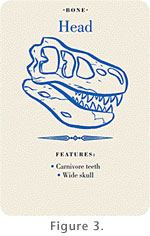 The tagline for Bone
Wars, The Ruthless Game of Paleontology, is apt. That is, game play
centers often more on preventing the other players from succeeding than
trying to get yourself to win. Around my table, rivalries cropped up
between players as they kept revising each other’s Dinosaurs and
stealing and restealing prestige. I should point out that by the next
game new rivalries appeared, old ones were forgotten, and the largest
argument of the first night of game play was whether we should read all
the cards first or be surprised at what cards appeared in play. The
players around my table identified three main strategies to win the
game. A “quick and dirty” strategy in which a Dinosaur is described as
fast as possible but is very susceptible to revision, a “slow but
precise” strategy in which a Dinosaur is described if it is nearly
complete and/or the Bone cards correspond exactly to the Dinosaur, and a
“revisionist” strategy in which the player only revises other players’
Dinosaurs and cannot lose prestige through revision because they do not
produce anything themselves. If this sounds at all like the practice of
paleontology, it is probably on purpose. The creators have managed to
capture different aspects of taxonomy, publication, and fieldwork in
card form. Many of the cards will sound familiar such as Wait Until
He’s Dead, Switching Labels, and Mining the Basement.
The tagline for Bone
Wars, The Ruthless Game of Paleontology, is apt. That is, game play
centers often more on preventing the other players from succeeding than
trying to get yourself to win. Around my table, rivalries cropped up
between players as they kept revising each other’s Dinosaurs and
stealing and restealing prestige. I should point out that by the next
game new rivalries appeared, old ones were forgotten, and the largest
argument of the first night of game play was whether we should read all
the cards first or be surprised at what cards appeared in play. The
players around my table identified three main strategies to win the
game. A “quick and dirty” strategy in which a Dinosaur is described as
fast as possible but is very susceptible to revision, a “slow but
precise” strategy in which a Dinosaur is described if it is nearly
complete and/or the Bone cards correspond exactly to the Dinosaur, and a
“revisionist” strategy in which the player only revises other players’
Dinosaurs and cannot lose prestige through revision because they do not
produce anything themselves. If this sounds at all like the practice of
paleontology, it is probably on purpose. The creators have managed to
capture different aspects of taxonomy, publication, and fieldwork in
card form. Many of the cards will sound familiar such as Wait Until
He’s Dead, Switching Labels, and Mining the Basement.
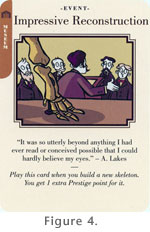 The game is not without
its issues, but there are only two that think bear mentioning. In Bone Wars there are three Field Crew cards. These are the only Event
cards that remain in play and give you an advantage while they remain in
play. However, there are also three other Event cards that let players
steal Field Crew cards (Better Food, Better Pay, and
Cask of Whiskey). Often, by the time a player plays a Field Crew
another player has a card that will take it from him or her. A player
must decide if they even want to play a Field Crew knowing it will
likely come back to bite them. Field Crews also have their own section
in the instructions to explain the special rules centered around these
three cards. Field Crews probably could have been left out or made a
larger part of the game to integrate them better with the rest of the
game. I would prefer the latter; I always take my chances and play the
Field Crew cards.
The game is not without
its issues, but there are only two that think bear mentioning. In Bone Wars there are three Field Crew cards. These are the only Event
cards that remain in play and give you an advantage while they remain in
play. However, there are also three other Event cards that let players
steal Field Crew cards (Better Food, Better Pay, and
Cask of Whiskey). Often, by the time a player plays a Field Crew
another player has a card that will take it from him or her. A player
must decide if they even want to play a Field Crew knowing it will
likely come back to bite them. Field Crews also have their own section
in the instructions to explain the special rules centered around these
three cards. Field Crews probably could have been left out or made a
larger part of the game to integrate them better with the rest of the
game. I would prefer the latter; I always take my chances and play the
Field Crew cards.
The other issue is one about game play. The instructions are quite short for a game of this type. The entire set if rules can fit on the two sides of an 8 1/2 by 11 inch sheet of paper. Terse instructions are generally a good idea for card games and the game has obviously been well play tested (the credits list 17 play testers), but one more aspect should be included. Many CCG’s have rules about timing, that is, what order certain cards or effects take affect if they happen at the about same time. Multiple Event cards can be played at the same time by different players, and it sometimes it has to be decided what order they should take affect. At my table, we decided to resolve the Events in the order they were played from last to first. This mechanic is used by many CCG’s and works quite well. Players not familiar with this type of card games might find it counter-intuitive. “By the book” players may want to tap on the table or otherwise show that they do not want to play any more cards at a particular time.
Another aspect mentioned by a colleague of mine is that Mary Anning should have been included as one of the Paleontologist cards to denote the contributions of women to paleontology. I do not disagree, but she was unfortunately not part of the American bone wars, which were at the time an all boys club. However, many of the cards show a female paleontologist doing such things as discovering a Dinosaur Graveyard, going on a Lecture Tour, and so on. Mary may be represented in the game after all, if not specifically by name.
Bone Wars is mainly distributed though Zygote Games’ website but is also sold at the Yale Peabody Museum Store. The game has been selling for about a year after the creators hosted a demo session at last year’s Dino Days. The game has enjoyed brisk sales, and is one of the top sellers in the card and board games category of the Peabody Museum Store. It is also unusual in that it is one of the few products stocked in both the adult and children’s sections of the store. In the children’s section it is placed higher up than many products to be closer to the eye line of older children. One of the take home messages from the demo was that younger children can play the game, but older children and adults were enjoying the game on another level.
In a world where dinosaur movies, games, and toys make millions of dollars off the efforts of paleontologists, my main complaint has been the quality of their work. If the entertainment industries were going to profit from our work, at least they could do a better job. Anyone who has picked up a plastic bag of “dinosaurs” that had both a Dimetrodon and a Wooly Mammoth in it probably has had similar thoughts. Zygote Games is run by a husband and wife team of a biologist and game designer. There website sports a history lesson behind the cards, a suggested reading list, and a science blog. If all new games were created in similar manner, there would be a lot better science games on the market, and a lot better-designed games in general. Zygote games is bringing similar flare to its upcoming release, Parasites Unleashed, in which the different disgusting and fascinating aspects of parasite lifecycles are depicted in a similar cartoon-like and humorous outlook that they brought to Bone Wars. Bone Wars will not be the last card game I ever buy, but it will be in the top of the rotation in my game box.
As a final note, if you do decide to play the game in the field, I would suggest packing the cards in two regular playing card boxes. The box Bone Wars is packaged in normal card stock and has a tendency to dent and have its corners bend in a pack. Special thanks for this review goes to Matt Benoit and Uná Farrell, who were the other players across the table at that first game, and Kathleen Sullivan at the Yale Peabody Museum Store.
Bone Wars is recommended for 2 to 4 players for ages 10 and up, but is equally playable by older children and adults. Bone Wars retails for $19.95, but a 10% discount is offered for orders coming from an educational address.